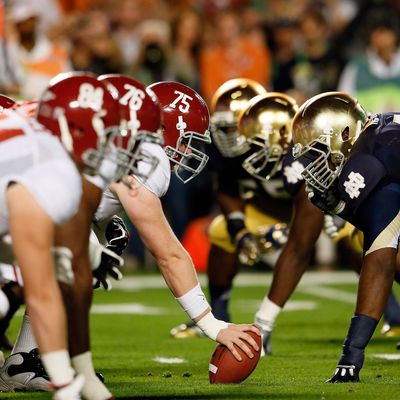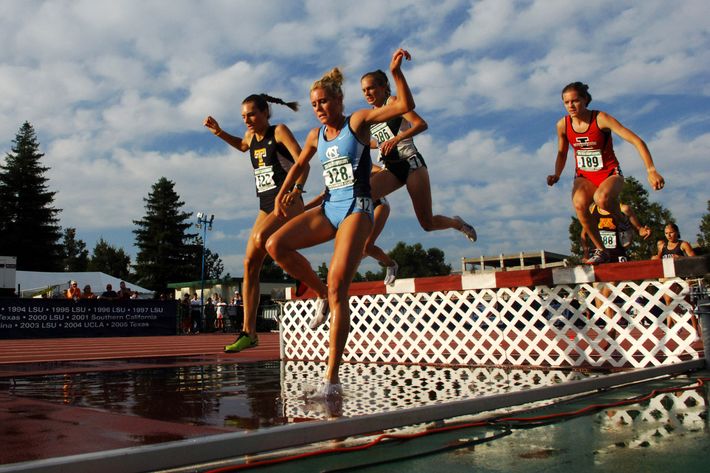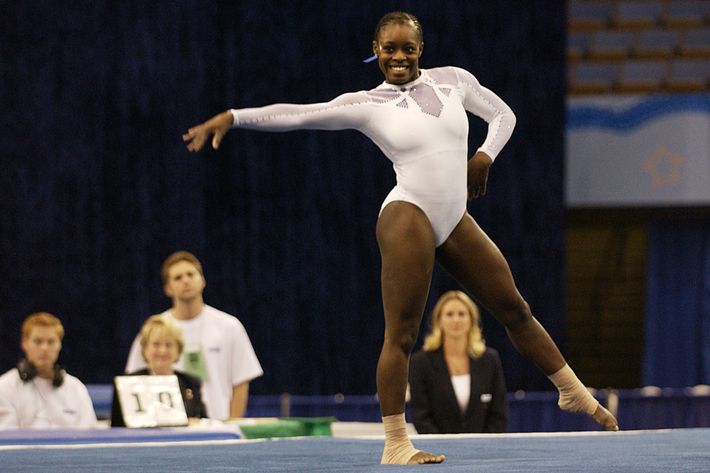
My argument that letting college athletes sell their fame is a bad idea because it would essentially legalize unlimited booster payments makes me one of the few people arguing against the increasing marketization of college sports and has raised a number of hackles. Here’s Scott Lemieux saying I oppose “allowing players to be directly compensated for their labor by universities”; here’s Kevin Carey likewise asserting that I advocate that “Athletes should work at a huge discount.”
Of course, their entire argument is contained within their unstated premise: that college athletes are workers performing labor, an assumption he advances by analogizing college athletes to journalists or other workers. If that’s true, then the solution is surely pretty obvious. As Lemieux has argued, “To describe this state of affairs is to make the remedy clear to any clear-thinking person.” But if you don’t accept his description of the state of affairs, the remedy isn’t clear at all. And I don’t accept the assumption that college athletes are simply unpaid workers.
College athletics occupy a somewhat tricky gray area between simple extracurricular activity and labor. The classic college athletic ideal is to consider varsity sports an activity like any other. You have a bunch of college students who really love playing sports, and the university gives them a scholarship because having competitive athletic programs adds to the campus culture and school spirit. Some of those students turn out to be good enough at their sport to do it professionally, while most “go pro in something other than sports,” as the NCAA commercial tells us:
Obviously the ideal does not perfectly describe the current situation, especially in extreme cases like John Calipari’s one-and-done conveyor belt at Kentucky, but to lesser degrees elsewhere. Despite Lemieux’s framing, I’m not a “defender” of the status quo. I want to improve it so as to restore rather than abandon the ideal.
But before I get into that, consider how well the alternative model holds up. If the purist model doesn’t fit the status quo, how well does the cynical model? The amateur ideal of college athletics is constantly on trial, every gap between it and reality magnified and held up as a point for the cynics — not least because the elements of the system that do the most violence to the ideal are also the most high profile.
Since the market cynics are arguing for an alternative, they rarely have to defend their own model. Their conception of college athletes as mere unpaid (or at least underpaid) workers, cruelly exploited by the system, is spared the work of answering for its own imperfections, all the ways in which messy reality fails to line up with the neat theory. But the market-cynic analysis turns out to be a much, much worse way to think about college athletes.
Begin with the premise: College athletes, or at least the ones in high level football and men’s basketball, are essentially unpaid factory workers. How does this model explain the existence of walk-on players, who line up at student body try-outs for a chance to play on the team without even a scholarship? How does it explain the fact that some players who are already locks for the top of the first round of the draft decide to stay for a final year in college, knowing it will cost them money? How does it explain alumni who donate money to their alma mater? (The examples I’ve linked above come from the University of Michigan, which I know about because I follow it closely, but these things all happen elsewhere, too.) You really don’t see refugees from exploitative factories coming back to cheer for and donate money to their former masters.
What’s more, the casual association of college athletes with workers hides a fundamental economic incoherence. College athletic programs, unlike professional franchises, have no owners or profits. Sports that make money, usually football and men’s basketball, subsidize money-losing sports.

If you think closely about the implications of this fact, it turns the labor-exploitation model into hash. Treating college athletes like workers assumes that players for money-generation sports — and only money-generating sports, deserve to keep the profit their sport generates. But why should a football player at Texas or Vanderbilt earn more than one at Georgia State or Grambling? Why should a men’s basketball player be paid something while a woman’s basketball player isn’t?
The only answer is that the former has a paid audience and the latter does not. A college student who plays a sport and gets a scholarship is presumably receiving fair treatment only until such point as his team attracts enough fans to the stadium or cable television to exceed the cost to the school of sponsoring the sport.
If a sport doesn’t need to make more than it costs the university for its participants to be considered exploited labor, then the underpaid workers include not just your Duke power forwards and Auburn linebackers but also your Cal Poly football squad, Swarthmore gymnastics, and, you could just as easily argue, marching bands and debate clubs. That’s why the market cynics limit their critique to the highest level football and men’s basketball players. They’re “unpaid workers,” while other college athletes — the vast majority — are just college athletes. But the college athletes in the one category — exploited laborers — are often doing the exact same thing, under the exact same terms, as the college athletes in the other category. The arbitrariness of these categories underscore the moral and economic incoherence of the marketers cynicism.

The larger problem is that their plan lacks any close connection to the actual problems of college sports, which are real. A reform plan that actually addresses the reality of the situation would recognize that most college athletes, including men’s football and basketball players, understand the benefits of a college degree. The trouble is that sports have grown so important they have elbowed out academics. College athletes face immense demands on their time, often giving them time to do little more than stay academically eligible. Some football programs, especially in the SEC, cancel scholarships for players who don’t develop into starters.
Professionalizing college sports would not alleviate these problems. It would likely worsen them, by weakening the link between student athletes and school, and explicitly commoditizing their athletic contributions. The best professional football players may be rich, but most of them are treated as disposable parts.
There are some moderate proposals to pay stipends to college athletes to reflect the true cost of attendance. That’s all sensible enough. A scholarship student should be able to afford clothes and pizza. The line to draw is differentiating players on the basis of their financial value, like professional athletes. I’d love to see the NCAA wrangle the pros into subsidizing more effective minor leagues in football and basketball for athletes who have no interest in, or ability to, get any kind of college education. (This would require a subsidy, a fact which underscores the reality that sub-professional players by themselves have little market value.)
The more important protection college athletes deserve is of their access to college education. Obviously not all college athletes are scholars — many are, while some use their athletic ability to get a degree to vault them into a middle class job as a teacher, coach, police officer, and so on. Protecting their chance to get that degree ought to mean giving every scholarship athlete five years of guaranteed full-ride tuition to complete four years of athletic eligibility. Those sorts of reforms like the cynical simplicity of professionalizing college sports. But the most cynical solution is not always the most realistic one.






























